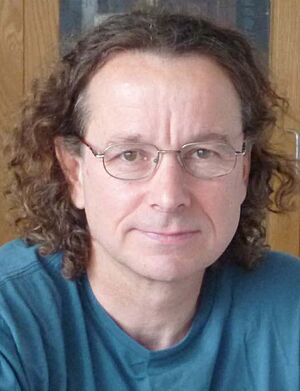Roderick MacKinnon facts for kids
Quick facts for kids
Roderick MacKinnon
|
|
|---|---|

MacKinnon in 2014
|
|
| Born | February 19, 1956 |
| Nationality | American |
| Alma mater |
|
| Known for | Potassium Channel Structure |
| Spouse(s) | Jue Chen (2017–) |
| Awards |
|
| Scientific career | |
| Fields | Chemistry |
| Institutions | |
Roderick MacKinnon (born February 19, 1956) is an American scientist. He studies how living things work at a very small level, like how tiny parts of our cells behave. He is a professor at Rockefeller University. In 2003, he won the Nobel Prize in Chemistry along with Peter Agre. They won for their important work on how "ion channels" are built and how they work.
Contents
About Roderick MacKinnon
Early Life and School
Roderick MacKinnon was born in Burlington, Massachusetts. He first went to the University of Massachusetts Boston. After one year, he moved to Brandeis University. There, he earned a bachelor's degree in biochemistry in 1978. For his final project, he studied how calcium moves through the outer layer of cells, called the cell membrane. At Brandeis, he also met Alice Lee, who would later become his wife and a fellow scientist.
After getting his first degree, MacKinnon went to medical school at Tufts University. He became a doctor in 1982. However, he realized he was more interested in scientific research than in being a medical doctor. So, in 1986, he went back to Brandeis University to do more research.
His Career in Science
In 1989, Roderick MacKinnon became a professor at Harvard University. He studied how a special type of potassium channel interacts with a poison from scorpion venom. This work helped him learn how to clean and study tiny parts of cells called proteins. He also learned about a method called X-ray crystallography. This method uses X-rays to figure out the exact shape of tiny molecules.
In 1996, he moved to Rockefeller University. There, he became a professor and led a lab that studied how molecules work in our nervous system. He started focusing on the structure of potassium channels. These channels are very important for our nervous system and our heart. They allow potassium particles, called ions, to move across the cell membrane.
Amazing Discoveries About Cells
How Potassium Channels Work
Potassium channels have a surprising job. They let potassium ions pass through, but they stop much smaller sodium ions. Before MacKinnon's work, scientists didn't know exactly how these channels worked. They didn't understand their detailed shape or how they chose which ions to let through.
In 1998, MacKinnon and his team made a huge breakthrough. It was very hard to study the structure of these channels. But they used X-ray crystallography to figure out the 3D shape of a potassium channel. This channel came from a tiny bacteria called Streptomyces lividans.
With this new information, MacKinnon and his colleagues could finally explain how potassium channels are so good at picking only potassium ions. They discovered the exact way these channels act like a special filter.
His Nobel Prize-winning research was done at special facilities. These included the Cornell High Energy Synchrotron Source at Cornell University and the National Synchrotron Light Source at Brookhaven National Laboratory. These places have powerful machines that help scientists study tiny structures.
In 2005, MacKinnon was chosen to be a member of the American Philosophical Society. In 2007, he became a foreign member of the Royal Netherlands Academy of Arts and Sciences. These are groups that recognize important scientists.
Awards and Special Recognition
Roderick MacKinnon has received many important awards for his scientific work:
- 1997: Newcomb Cleveland Prize
- 1998: W. Alden Spencer Award
- 1999: Albert Lasker Basic Medical Research Award
- 2000: Rosenstiel Award
- 2001: Gairdner Foundation International Award
- 2003: Louisa Gross Horwitz Prize
- 2003: Nobel Prize in Chemistry
Business Ventures
Roderick MacKinnon also worked on a business idea with his friend, Bruce Bean. They invented a special dietary supplement to help with and prevent muscle cramps. They tested it and started a company called Flex Pharma to sell their invention.
The company launched a product called "HotShot" in 2016. It was a dietary supplement for athletes who do a lot of exercise. MacKinnon later left the company's board of directors in July 2018.
See also
 In Spanish: Roderick MacKinnon para niños
In Spanish: Roderick MacKinnon para niños

